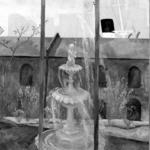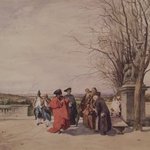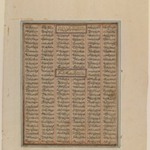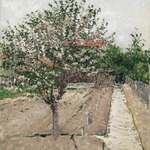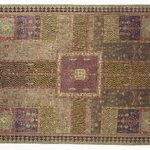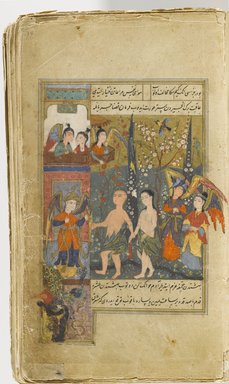

Muhammad bin Sulayman, known as Fuzuli (ca. 1483–1556). Manuscript of the Hadiqat al-Su`ada (Garden of the Blessed) of Fuzuli, AH 1011 / 1602–3 C.E. Opaque watercolor, ink and gold on paper; leather binding, 5 1/2 x 9 3/4 in. (14 x 24.8 cm). Brooklyn Museum, Gift of Mr. and Mrs. Charles K. Wilkinson, 70.143 (Photo: Brooklyn Museum, 70.143_p014_PS6.jpg)

Muhammad bin Sulayman, known as Fuzuli (ca. 1483–1556). Manuscript of the Hadiqat al-Su`ada (Garden of the Blessed) of Fuzuli, AH 1011 / 1602–3 C.E. Opaque watercolor, ink and gold on paper; leather binding, 5 1/2 x 9 3/4 in. (14 x 24.8 cm). Brooklyn Museum, Gift of Mr. and Mrs. Charles K. Wilkinson, 70.143 (Photo: Brooklyn Museum, 70.143_p082_detail_PS6.jpg)

Muhammad bin Sulayman, known as Fuzuli (ca. 1483–1556). Manuscript of the Hadiqat al-Su`ada (Garden of the Blessed) of Fuzuli, AH 1011 / 1602–3 C.E. Opaque watercolor, ink and gold on paper; leather binding, 5 1/2 x 9 3/4 in. (14 x 24.8 cm). Brooklyn Museum, Gift of Mr. and Mrs. Charles K. Wilkinson, 70.143 (Photo: Brooklyn Museum, 70.143_p082_PS6.jpg)

Muhammad bin Sulayman, known as Fuzuli (ca. 1483–1556). Manuscript of the Hadiqat al-Su`ada (Garden of the Blessed) of Fuzuli, AH 1011 / 1602–3 C.E. Opaque watercolor, ink and gold on paper; leather binding, 5 1/2 x 9 3/4 in. (14 x 24.8 cm). Brooklyn Museum, Gift of Mr. and Mrs. Charles K. Wilkinson, 70.143 (Photo: Brooklyn Museum, 70.143_p144_PS6.jpg)

Muhammad bin Sulayman, known as Fuzuli (ca. 1483–1556). Manuscript of the Hadiqat al-Su`ada (Garden of the Blessed) of Fuzuli, AH 1011 / 1602–3 C.E. Opaque watercolor, ink and gold on paper; leather binding, 5 1/2 x 9 3/4 in. (14 x 24.8 cm). Brooklyn Museum, Gift of Mr. and Mrs. Charles K. Wilkinson, 70.143 (Photo: Brooklyn Museum, 70.143_p218_PS6.jpg)

Muhammad bin Sulayman, known as Fuzuli (ca. 1483–1556). Manuscript of the Hadiqat al-Su`ada (Garden of the Blessed) of Fuzuli, AH 1011 / 1602–3 C.E. Opaque watercolor, ink and gold on paper; leather binding, 5 1/2 x 9 3/4 in. (14 x 24.8 cm). Brooklyn Museum, Gift of Mr. and Mrs. Charles K. Wilkinson, 70.143 (Photo: Brooklyn Museum, 70.143_p260_PS6.jpg)
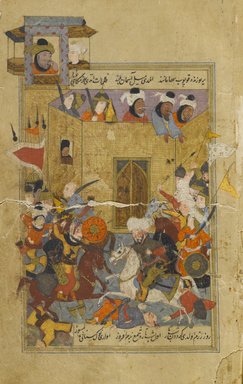
Muhammad bin Sulayman, known as Fuzuli (ca. 1483–1556). Manuscript of the Hadiqat al-Su`ada (Garden of the Blessed) of Fuzuli, AH 1011 / 1602–3 C.E. Opaque watercolor, ink and gold on paper; leather binding, 5 1/2 x 9 3/4 in. (14 x 24.8 cm). Brooklyn Museum, Gift of Mr. and Mrs. Charles K. Wilkinson, 70.143 (Photo: Brooklyn Museum, 70.143_p324.jpg)

Muhammad bin Sulayman, known as Fuzuli (ca. 1483–1556). Manuscript of the Hadiqat al-Su`ada (Garden of the Blessed) of Fuzuli, AH 1011 / 1602–3 C.E. Opaque watercolor, ink and gold on paper; leather binding, 5 1/2 x 9 3/4 in. (14 x 24.8 cm). Brooklyn Museum, Gift of Mr. and Mrs. Charles K. Wilkinson, 70.143 (Photo: Brooklyn Museum, 70.143_p324_PS6.jpg)

Muhammad bin Sulayman, known as Fuzuli (ca. 1483–1556). Manuscript of the Hadiqat al-Su`ada (Garden of the Blessed) of Fuzuli, AH 1011 / 1602–3 C.E. Opaque watercolor, ink and gold on paper; leather binding, 5 1/2 x 9 3/4 in. (14 x 24.8 cm). Brooklyn Museum, Gift of Mr. and Mrs. Charles K. Wilkinson, 70.143 (Photo: Brooklyn Museum, 70.143_p462_PS6.jpg)

Muhammad bin Sulayman, known as Fuzuli (ca. 1483–1556). Manuscript of the Hadiqat al-Su`ada (Garden of the Blessed) of Fuzuli, AH 1011 / 1602–3 C.E. Opaque watercolor, ink and gold on paper; leather binding, 5 1/2 x 9 3/4 in. (14 x 24.8 cm). Brooklyn Museum, Gift of Mr. and Mrs. Charles K. Wilkinson, 70.143 (Photo: Brooklyn Museum, 70.143_p506_PS6.jpg)

Muhammad bin Sulayman, known as Fuzuli (ca. 1483–1556). Manuscript of the Hadiqat al-Su`ada (Garden of the Blessed) of Fuzuli, AH 1011 / 1602–3 C.E. Opaque watercolor, ink and gold on paper; leather binding, 5 1/2 x 9 3/4 in. (14 x 24.8 cm). Brooklyn Museum, Gift of Mr. and Mrs. Charles K. Wilkinson, 70.143 (Photo: Brooklyn Museum, 70.143_p560_PS6.jpg)

Muhammad bin Sulayman, known as Fuzuli (ca. 1483–1556). Manuscript of the Hadiqat al-Su`ada (Garden of the Blessed) of Fuzuli, AH 1011 / 1602–3 C.E. Opaque watercolor, ink and gold on paper; leather binding, 5 1/2 x 9 3/4 in. (14 x 24.8 cm). Brooklyn Museum, Gift of Mr. and Mrs. Charles K. Wilkinson, 70.143 (Photo: Brooklyn Museum, 70.143_p580_PS6.jpg)

Muhammad bin Sulayman, known as Fuzuli (ca. 1483–1556). Manuscript of the Hadiqat al-Su`ada (Garden of the Blessed) of Fuzuli, AH 1011 / 1602–3 C.E. Opaque watercolor, ink and gold on paper; leather binding, 5 1/2 x 9 3/4 in. (14 x 24.8 cm). Brooklyn Museum, Gift of Mr. and Mrs. Charles K. Wilkinson, 70.143 (Photo: Brooklyn Museum, 70.143_page000_frontispiece_PS6.jpg)

Muhammad bin Sulayman, known as Fuzuli (ca. 1483–1556). Manuscript of the Hadiqat al-Su`ada (Garden of the Blessed) of Fuzuli, AH 1011 / 1602–3 C.E. Opaque watercolor, ink and gold on paper; leather binding, 5 1/2 x 9 3/4 in. (14 x 24.8 cm). Brooklyn Museum, Gift of Mr. and Mrs. Charles K. Wilkinson, 70.143 (Photo: Brooklyn Museum, 70.143_page014_IMLS_SL2.jpg)

Muhammad bin Sulayman, known as Fuzuli (ca. 1483–1556). Manuscript of the Hadiqat al-Su`ada (Garden of the Blessed) of Fuzuli, AH 1011 / 1602–3 C.E. Opaque watercolor, ink and gold on paper; leather binding, 5 1/2 x 9 3/4 in. (14 x 24.8 cm). Brooklyn Museum, Gift of Mr. and Mrs. Charles K. Wilkinson, 70.143 (Photo: Brooklyn Museum, 70.143_mark1_PS6.jpg)

Muhammad bin Sulayman, known as Fuzuli (ca. 1483–1556). Manuscript of the Hadiqat al-Su`ada (Garden of the Blessed) of Fuzuli, AH 1011 / 1602–3 C.E. Opaque watercolor, ink and gold on paper; leather binding, 5 1/2 x 9 3/4 in. (14 x 24.8 cm). Brooklyn Museum, Gift of Mr. and Mrs. Charles K. Wilkinson, 70.143 (Photo: Brooklyn Museum, 70.143_mark2_PS6.jpg)
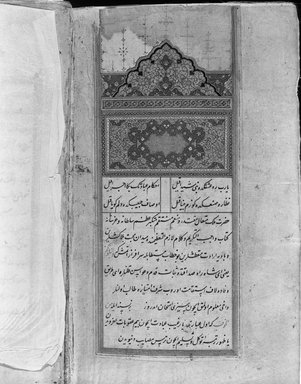
Muhammad bin Sulayman, known as Fuzuli (ca. 1483–1556). Manuscript of the Hadiqat al-Su`ada (Garden of the Blessed) of Fuzuli, AH 1011 / 1602–3 C.E. Opaque watercolor, ink and gold on paper; leather binding, 5 1/2 x 9 3/4 in. (14 x 24.8 cm). Brooklyn Museum, Gift of Mr. and Mrs. Charles K. Wilkinson, 70.143 (Photo: Brooklyn Museum, 70.143_page000_frontispiece_bw_IMLS.jpg)

Muhammad bin Sulayman, known as Fuzuli (ca. 1483–1556). Manuscript of the Hadiqat al-Su`ada (Garden of the Blessed) of Fuzuli, AH 1011 / 1602–3 C.E. Opaque watercolor, ink and gold on paper; leather binding, 5 1/2 x 9 3/4 in. (14 x 24.8 cm). Brooklyn Museum, Gift of Mr. and Mrs. Charles K. Wilkinson, 70.143 (Photo: Brooklyn Museum, 70.143_page014_bw_IMLS.jpg)
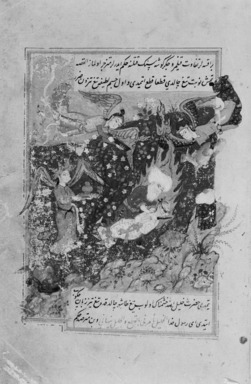
Muhammad bin Sulayman, known as Fuzuli (ca. 1483–1556). Manuscript of the Hadiqat al-Su`ada (Garden of the Blessed) of Fuzuli, AH 1011 / 1602–3 C.E. Opaque watercolor, ink and gold on paper; leather binding, 5 1/2 x 9 3/4 in. (14 x 24.8 cm). Brooklyn Museum, Gift of Mr. and Mrs. Charles K. Wilkinson, 70.143 (Photo: Brooklyn Museum, 70.143_p038_bw_SL3.jpg)

Muhammad bin Sulayman, known as Fuzuli (ca. 1483–1556). Manuscript of the Hadiqat al-Su`ada (Garden of the Blessed) of Fuzuli, AH 1011 / 1602–3 C.E. Opaque watercolor, ink and gold on paper; leather binding, 5 1/2 x 9 3/4 in. (14 x 24.8 cm). Brooklyn Museum, Gift of Mr. and Mrs. Charles K. Wilkinson, 70.143 (Photo: Brooklyn Museum, 70.143_page082_bw_IMLS.jpg)

Muhammad bin Sulayman, known as Fuzuli (ca. 1483–1556). Manuscript of the Hadiqat al-Su`ada (Garden of the Blessed) of Fuzuli, AH 1011 / 1602–3 C.E. Opaque watercolor, ink and gold on paper; leather binding, 5 1/2 x 9 3/4 in. (14 x 24.8 cm). Brooklyn Museum, Gift of Mr. and Mrs. Charles K. Wilkinson, 70.143 (Photo: Brooklyn Museum, 70.143_page144_bw_IMLS.jpg)

Muhammad bin Sulayman, known as Fuzuli (ca. 1483–1556). Manuscript of the Hadiqat al-Su`ada (Garden of the Blessed) of Fuzuli, AH 1011 / 1602–3 C.E. Opaque watercolor, ink and gold on paper; leather binding, 5 1/2 x 9 3/4 in. (14 x 24.8 cm). Brooklyn Museum, Gift of Mr. and Mrs. Charles K. Wilkinson, 70.143 (Photo: Brooklyn Museum, 70.143_page218_bw_IMLS.jpg)
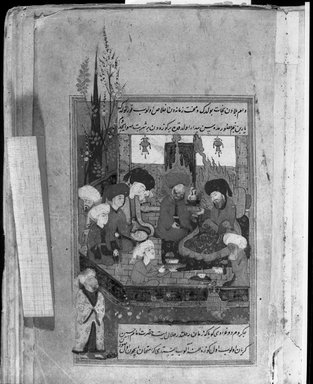
Muhammad bin Sulayman, known as Fuzuli (ca. 1483–1556). Manuscript of the Hadiqat al-Su`ada (Garden of the Blessed) of Fuzuli, AH 1011 / 1602–3 C.E. Opaque watercolor, ink and gold on paper; leather binding, 5 1/2 x 9 3/4 in. (14 x 24.8 cm). Brooklyn Museum, Gift of Mr. and Mrs. Charles K. Wilkinson, 70.143 (Photo: Brooklyn Museum, 70.143_page260_bw_IMLS.jpg)

Muhammad bin Sulayman, known as Fuzuli (ca. 1483–1556). Manuscript of the Hadiqat al-Su`ada (Garden of the Blessed) of Fuzuli, AH 1011 / 1602–3 C.E. Opaque watercolor, ink and gold on paper; leather binding, 5 1/2 x 9 3/4 in. (14 x 24.8 cm). Brooklyn Museum, Gift of Mr. and Mrs. Charles K. Wilkinson, 70.143 (Photo: Brooklyn Museum, 70.143_page324_bw_IMLS.jpg)

Muhammad bin Sulayman, known as Fuzuli (ca. 1483–1556). Manuscript of the Hadiqat al-Su`ada (Garden of the Blessed) of Fuzuli, AH 1011 / 1602–3 C.E. Opaque watercolor, ink and gold on paper; leather binding, 5 1/2 x 9 3/4 in. (14 x 24.8 cm). Brooklyn Museum, Gift of Mr. and Mrs. Charles K. Wilkinson, 70.143 (Photo: Brooklyn Museum, 70.143_page462_bw_IMLS.jpg)

Muhammad bin Sulayman, known as Fuzuli (ca. 1483–1556). Manuscript of the Hadiqat al-Su`ada (Garden of the Blessed) of Fuzuli, AH 1011 / 1602–3 C.E. Opaque watercolor, ink and gold on paper; leather binding, 5 1/2 x 9 3/4 in. (14 x 24.8 cm). Brooklyn Museum, Gift of Mr. and Mrs. Charles K. Wilkinson, 70.143 (Photo: Brooklyn Museum, 70.143_page505_bw_IMLS.jpg)

Muhammad bin Sulayman, known as Fuzuli (ca. 1483–1556). Manuscript of the Hadiqat al-Su`ada (Garden of the Blessed) of Fuzuli, AH 1011 / 1602–3 C.E. Opaque watercolor, ink and gold on paper; leather binding, 5 1/2 x 9 3/4 in. (14 x 24.8 cm). Brooklyn Museum, Gift of Mr. and Mrs. Charles K. Wilkinson, 70.143 (Photo: Brooklyn Museum, 70.143_page506_bw_IMLS.jpg)

Muhammad bin Sulayman, known as Fuzuli (ca. 1483–1556). Manuscript of the Hadiqat al-Su`ada (Garden of the Blessed) of Fuzuli, AH 1011 / 1602–3 C.E. Opaque watercolor, ink and gold on paper; leather binding, 5 1/2 x 9 3/4 in. (14 x 24.8 cm). Brooklyn Museum, Gift of Mr. and Mrs. Charles K. Wilkinson, 70.143 (Photo: Brooklyn Museum, 70.143_page560_bw_IMLS.jpg)

Muhammad bin Sulayman, known as Fuzuli (ca. 1483–1556). Manuscript of the Hadiqat al-Su`ada (Garden of the Blessed) of Fuzuli, AH 1011 / 1602–3 C.E. Opaque watercolor, ink and gold on paper; leather binding, 5 1/2 x 9 3/4 in. (14 x 24.8 cm). Brooklyn Museum, Gift of Mr. and Mrs. Charles K. Wilkinson, 70.143 (Photo: Brooklyn Museum, 70.143_page580_bw_IMLS.jpg)
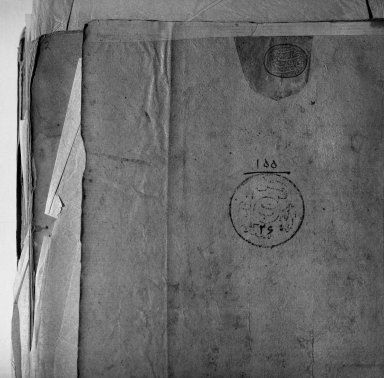
Muhammad bin Sulayman, known as Fuzuli (ca. 1483–1556). Manuscript of the Hadiqat al-Su`ada (Garden of the Blessed) of Fuzuli, AH 1011 / 1602–3 C.E. Opaque watercolor, ink and gold on paper; leather binding, 5 1/2 x 9 3/4 in. (14 x 24.8 cm). Brooklyn Museum, Gift of Mr. and Mrs. Charles K. Wilkinson, 70.143 (Photo: Brooklyn Museum, 70.143_mark1_bw_IMLS.jpg)

Muhammad bin Sulayman, known as Fuzuli (ca. 1483–1556). Manuscript of the Hadiqat al-Su`ada (Garden of the Blessed) of Fuzuli, AH 1011 / 1602–3 C.E. Opaque watercolor, ink and gold on paper; leather binding, 5 1/2 x 9 3/4 in. (14 x 24.8 cm). Brooklyn Museum, Gift of Mr. and Mrs. Charles K. Wilkinson, 70.143 (Photo: Brooklyn Museum, 70.143_mark2_bw_IMLS.jpg)

Muhammad bin Sulayman, known as Fuzuli (ca. 1483–1556). Manuscript of the Hadiqat al-Su`ada (Garden of the Blessed) of Fuzuli, AH 1011 / 1602–3 C.E. Opaque watercolor, ink and gold on paper; leather binding, 5 1/2 x 9 3/4 in. (14 x 24.8 cm). Brooklyn Museum, Gift of Mr. and Mrs. Charles K. Wilkinson, 70.143 (Photo: Brooklyn Museum, 70.143_mark3_bw_IMLS.jpg)
Manuscript of the Hadiqat al-Su`ada (Garden of the Blessed) of Fuzuli
Arts of the Islamic World



